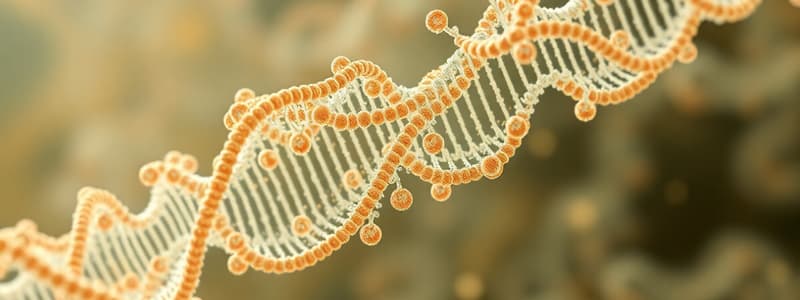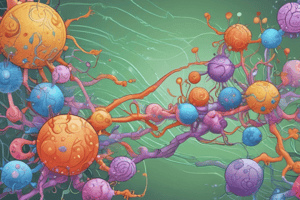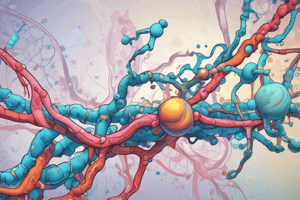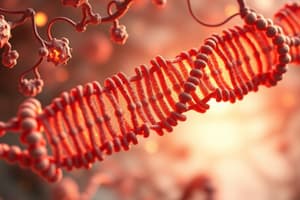Podcast
Questions and Answers
What primarily determines steady-state mRNA levels?
What primarily determines steady-state mRNA levels?
- mRNA length
- Rate of transcription only
- Balance between synthesis and degradation (correct)
- Rate of translation only
The stabilities (half-lives) of mRNAs and their corresponding proteins are strongly correlated, indicating a linked degradation mechanism.
The stabilities (half-lives) of mRNAs and their corresponding proteins are strongly correlated, indicating a linked degradation mechanism.
False (B)
What is the typical range of mRNA half-lives?
What is the typical range of mRNA half-lives?
minutes to tens of hours
The process of mRNA degradation is initiated by _______, which is the removal of the poly-A tail.
The process of mRNA degradation is initiated by _______, which is the removal of the poly-A tail.
Match the mRNA degradation pathway with its corresponding enzyme:
Match the mRNA degradation pathway with its corresponding enzyme:
In the 5' to 3' mRNA decay pathway, what modification must occur before XRN1 can degrade the mRNA?
In the 5' to 3' mRNA decay pathway, what modification must occur before XRN1 can degrade the mRNA?
Endonucleolytic cleavage creates entry points for exonucleases and is part of mRNA surveillance.
Endonucleolytic cleavage creates entry points for exonucleases and is part of mRNA surveillance.
What is the main enzyme involved in deadenylation?
What is the main enzyme involved in deadenylation?
The heterodimer consisting of _______ and _______ is responsible for decapping mRNA.
The heterodimer consisting of _______ and _______ is responsible for decapping mRNA.
What structural feature on an RNA molecule does XRN1 recognize to initiate degradation?
What structural feature on an RNA molecule does XRN1 recognize to initiate degradation?
Deadenylation always leads to immediate degradation of the mRNA molecule.
Deadenylation always leads to immediate degradation of the mRNA molecule.
Besides degradation, what other process is mRNA decay often coupled with?
Besides degradation, what other process is mRNA decay often coupled with?
_______ elements in the 3' UTR of mRNA act as control hubs for regulated mRNA decay by recruiting RNA-binding proteins.
_______ elements in the 3' UTR of mRNA act as control hubs for regulated mRNA decay by recruiting RNA-binding proteins.
Match each mRNA surveillance pathway with its trigger:
Match each mRNA surveillance pathway with its trigger:
What is the role of the Exon Junction Complex (EJC) in Nonsense-Mediated Decay (NMD)?
What is the role of the Exon Junction Complex (EJC) in Nonsense-Mediated Decay (NMD)?
The Non-Stop Decay (NSD) pathway is dependent on the same set of factors (UPF1, XRN1, DCP1/2, CCR4-NOT) as the Nonsense-Mediated Decay (NMD) pathway.
The Non-Stop Decay (NSD) pathway is dependent on the same set of factors (UPF1, XRN1, DCP1/2, CCR4-NOT) as the Nonsense-Mediated Decay (NMD) pathway.
What cellular component does Dom34 structurally mimic in the No-Go Decay (NGD) pathway, and what function does it perform?
What cellular component does Dom34 structurally mimic in the No-Go Decay (NGD) pathway, and what function does it perform?
XRN1 activity is blocked by _______ or _______ at the 5' end of mRNA because these groups cannot fit into the enzyme's phosphate-binding pocket.
XRN1 activity is blocked by _______ or _______ at the 5' end of mRNA because these groups cannot fit into the enzyme's phosphate-binding pocket.
Which of the following is NOT a function of P-bodies?
Which of the following is NOT a function of P-bodies?
Match each of the following enzymes with its function in mRNA degradation:
Match each of the following enzymes with its function in mRNA degradation:
Flashcards
mRNA Degradation
mRNA Degradation
Post-transcriptional process controlling mRNA levels.
Steady-state mRNA levels
Steady-state mRNA levels
Balance between mRNA synthesis and degradation.
mRNA half-lives
mRNA half-lives
Vary widely, from minutes to tens of hours.
Measuring mRNA Half-Life
Measuring mRNA Half-Life
Signup and view all the flashcards
mRNA Degradation (Active)
mRNA Degradation (Active)
Signup and view all the flashcards
Global mRNA Turnover
Global mRNA Turnover
Signup and view all the flashcards
Regulated mRNA Turnover
Regulated mRNA Turnover
Signup and view all the flashcards
mRNA Quality Control
mRNA Quality Control
Signup and view all the flashcards
Deadenylation
Deadenylation
Signup and view all the flashcards
Deadenylases
Deadenylases
Signup and view all the flashcards
Decapping
Decapping
Signup and view all the flashcards
XRN1
XRN1
Signup and view all the flashcards
Exosome complex
Exosome complex
Signup and view all the flashcards
Endonucleases
Endonucleases
Signup and view all the flashcards
Deadenylation (Importance)
Deadenylation (Importance)
Signup and view all the flashcards
Yeast mRNA Decay
Yeast mRNA Decay
Signup and view all the flashcards
Main Deadenylase Complexes
Main Deadenylase Complexes
Signup and view all the flashcards
NMD Purpose
NMD Purpose
Signup and view all the flashcards
Regulated mRNA Decay
Regulated mRNA Decay
Signup and view all the flashcards
P-bodies
P-bodies
Signup and view all the flashcards
Study Notes
Importance of mRNA Degradation
- A critical aspect of post-transcriptional gene regulation
- Steady-state mRNA levels result from a balance between synthesis and degradation
- Plays a role as significant as mRNA synthesis in gene expression control
mRNA vs. Protein Stability
- Studies show wide variation in both mRNA and protein abundance and half-lives
- mRNA and protein abundance are somewhat correlated
- Stabilities (half-lives) of mRNAs and corresponding proteins are not well correlated
Diversity of mRNA Half-Lives
- Range from minutes to tens of hours
- In mouse fibroblasts, median mRNA half-life is ~9 hours
- For some mRNAs, synthesis takes longer than their functional lifetime
Measuring mRNA Half-Life
- Method involves using a transcription inhibitor (e.g., α-amanitin) to stop RNA Pol II activity
- mRNA decay is monitored over time
- RNA extraction uses reagents like TRIzol to isolate RNA
- Quantification methods include Northern blot, RT-qPCR, or RNA-seq
- Data analysis involves plotting mRNA levels over time, fitting data to an exponential decay curve to determine half-life
Key Takeaway on mRNA Degradation
- Essential and highly variable
- Fundamental aspect of post-transcriptional gene regulation
Role in Gene Expression
- A key regulatory step in controlling mRNA levels and protein production
- Allows cells to adjust gene expression post-transcriptionally under various conditions
Global (Constitutive) mRNA Turnover
- All mRNAs undergo continuous synthesis and degradation
- Global turnover rate is influenced by mRNA decay factors, including nucleases and associated proteins
- Maintains a dynamic balance of the cellular mRNA pool
Regulated Turnover of Specific mRNAs
- Targeted degradation of individual mRNAs occurs in response to signals
- Enables fine-tuning of specific mRNA levels
- Regulated by RNA-binding proteins and microRNAs
- Often coupled with translational repression, where degradation and inhibition of translation co-occur
mRNA Quality Control (Surveillance)
- Mechanisms detect and degrade defective mRNAs, such as those lacking stop codons, with premature stop codons, or other translation-impairing defects
- Closely linked to translation, translation errors often trigger degradation
Key Takeaway on mRNA Degradation Process
- Not just passive decay
- An active, regulated process integrated with translation
- Essential for fine-tuning gene expression and maintaining mRNA integrity
Overview of Constitutive mRNA Degradation Pathways
- Constitutive mRNA turnover ensures continuous removal and replacement
- Initiated by deadenylation, which is the 3′ poly-A tail removal
Step 1: Deadenylation
- Catalyzed by deadenylase enzymes
- Produces an intermediate with a short poly-A tail, but an intact 5′ cap
- Rate-limiting and entry point for further degradation
5′ to 3′ Decay Pathway
- Decapping by DCP1–DCP2 complex removes the 5′ cap
- Leaves a 5′ monophosphate, a substrate for XRN1, a 5′→3′ exoribonuclease
- XRN1 degrades mRNA from the 5′ end
3′ to 5′ Decay Pathway
- The exosome complex (multi-protein) degrades the deadenylated 3′ end
- It proceeds in the 3′→5′ direction
Endonucleolytic Cleavage Pathway
- Endonucleases cleave the mRNA internally
- Produces a 3′ fragment lacking a poly-A tail, which is degraded by the exosome (3′→5′) and a 5′ fragment with a 5′ monophosphate, degraded by XRN1 (5′→3′)
- Entry point for specialized degradation pathways, including Nonsense-mediated decay (NMD), No-go decay (NGD), and siRNA-mediated RNA interference (RNAi), where initial cleavage is called slicing
Key Concepts of mRNA Degradation
- Deadenylation is the first and crucial step in canonical decay
- Degradation is directional and enzyme-specific, XRN1 for 5′→3′ and Exosome for 3′→5′
- Endonucleolytic cleavage creates direct entry points for exonucleases and is used in surveillance and silencing mechanisms
Discovery in Budding Yeast
- Early understanding of mRNA degradation comes from yeast studies
- They helped define the canonical degradation pathways
Main Enzymes Identified in Yeast
- Deadenylation: Main enzyme is CCR4
- Decapping: Heterodimer of DCP1 and DCP2, with DCP2 as the catalytic subunit
- 5′→3′ Exonuclease: XRN1, acts on RNAs with a 5′ monophosphate
Conservation Across Eukaryotes
- Homologs of DCP1, DCP2, and XRN1 are found in human cells and higher eukaryotes
- Enzyme names and functions are often retained in higher organisms
Pathway Dominance Varies by Organism
- In yeast, the 5′→3′ pathway (XRN1-dependent) is dominant
- In higher eukaryotes, dominance between 5′→3′ (XRN1 pathway) and 3′→5′ (Exosome pathway) varies by cell type and conditions
- No universal rule exists, both pathways may be active in different biological contexts
Summary of mRNA Degradation
- The core components of mRNA degradation were discovered in yeast and evolutionarily conserved
- The dominant pathway (5′→3′ vs 3′→5′) varies across organisms and conditions
Deadenylation: The First Step
- It refers to the removal of the poly-A tail, initiating degradation
- Three main deadenylase complexes are CCR4-NOT complex (major deadenylase), PAN2–PAN3 complex (catalyzes initial shortening), and PARN (specialized deadenylase)
3′ → 5′ Degradation: The Exosome
- A 10-subunit multi-protein complex
- Functions in cytoplasmic mRNA degradation and nuclear RNA processing
- The structure forms a central channel leading RNA to the exonuclease active site
- Regulated by RNA helicases and cofactors that help recruit and insert mRNAs into the exosome
- Ensures regulated access and degradation of deadenylated mRNAs
5′ → 3′ Degradation: XRN1
- Key 5′→3′ exonuclease
- Requires a 5′ monophosphate to function
- Blocked by 5′ caps or triphosphates
- Substrate specificity is ensured by a positively charged pocket that recognizes the 5′ phosphate
- Its mechanism is processive, each nucleotide cleavage leaves a 5′ monophosphate, allowing continuous degradation, and XRN1 stays bound and processes the mRNA without dissociating
Fidelity and Irreversibility
- Only decapped mRNAs can be degraded by XRN1
- Decapping commits the mRNA to degradation, and this process is irreversible
- This ensures precision and control in mRNA turnover
Key takeaways from mRNA Degradation
- Precisely regulated through structural and enzymatic specificity
- Begins with deadenylation and proceeds via the exosome or XRN1, depending on terminal modifications
- Enzyme design ensures fidelity, directionality, and irreversibility
Decapping Enzyme Complex
- Catalyzed by DCP1–DCP2 heterodimer, where DCP2 is the catalytic subunit and DCP1 is a co-activator required for full activity
- Activated and recruited by decapping activators (e.g., EDC4, EDC3, DHH1) and RNA-binding proteins that recognize deadenylated mRNAs
Link Between Decapping and Translation
- Actively translated mRNAs are protected from decapping and deadenylation by the 5′ cap, poly-A tail, and poly-A binding protein (PABP)
- PABP stabilizes the poly-A tail, enhances translation initiation, and prevents early degradation
- Translation competes with degradation, ongoing translation stabilizes mRNA, and reduced translation makes mRNA degradation easier
Mechanism of mRNA Destabilization
- PABP dissociates, reduces translation efficiency
- This promotes recruitment of decapping co-activators (e.g., DHH1, LSM1–7 complex) and assembly of decapping machinery at the 5' end
- Leads to decapping, then degradation by XRN1 (5'→3') or exosome (3'→5')
Studying That Suits You
Use AI to generate personalized quizzes and flashcards to suit your learning preferences.



